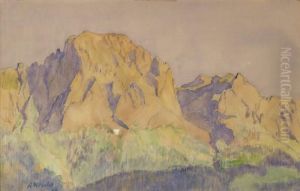Adolphe-Celestin Nicolet Paintings
Adolphe-Celestin Nicolet was a Swiss painter and watercolorist, primarily known for his landscapes and genre scenes. Born on April 6, 1799, in Chézard-Saint-Martin, a small village in the canton of Neuchâtel, Switzerland, Nicolet was part of the early 19th-century European art movement. He lived during a period when the Romantic movement was in full swing, influencing artists to emphasize emotion and individualism, as well as glorifying the past and nature.
Despite not being as widely recognized as some of his contemporaries, Nicolet made a considerable contribution to Swiss art, particularly through his depictions of the Swiss countryside and the daily lives of its inhabitants. His works often reflect a keen observation of nature and a delicate handling of light, which he used to create atmospheric effects in his landscapes.
In his early years, Nicolet may have been influenced by the works of other Swiss artists such as Alexandre Calame and François Diday, who were known for their dramatic Alpine scenes. However, Nicolet developed his own style, characterized by a more intimate and serene portrayal of the landscape. He worked in various media, including oil, watercolor, and prints, and his approach varied from detailed and realistic to more poetic and suggestive.
Throughout his career, Nicolet remained relatively local, drawing inspiration from the Neuchâtel region. He exhibited his work in various salons and galleries, gaining a modest reputation during his lifetime. His paintings appealed to a burgeoning middle class who were interested in scenes of rural life and the beauty of the Swiss countryside.
Adolphe-Celestin Nicolet's life was cut short when he passed away on January 15, 1842, at the age of 42. While he did not achieve the same level of fame as some of his European peers, his works continue to be appreciated for their contribution to the Swiss romantic landscape tradition. Today, Nicolet's paintings can be found in several Swiss museums, where they offer a window into the 19th-century Swiss soul and landscape.
